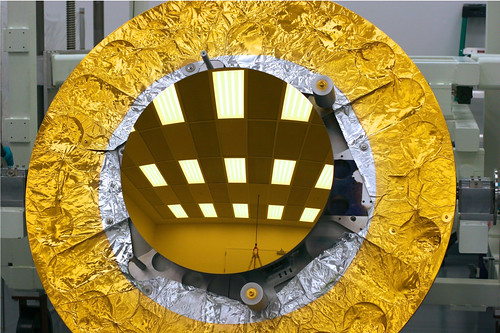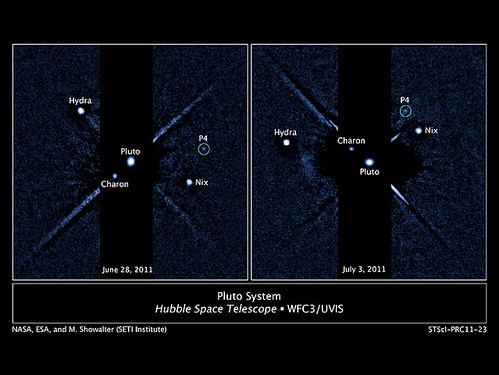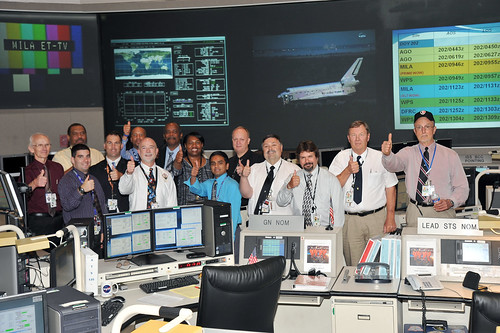Awesomeness Round-up – 7/26/11
- By Maggie Masetti
- July 26, 2011
- 3 Comments
The James Webb Space Telescope has had a lot of recent milestones. All the primary mirror segments have been polished – and the secondary mirror has just been completed. You can read a NASA web feature all about what Webb’s secondary mirror does and why it’s important. (It’s quite large too – nearly as big as the Spitzer Space Telescope’s primary mirror!)

Credit: Ball Aerospace
Scale is a funny thing in astronomy. Our planet seems pretty big and then we see an image of a solar flare that is many times its size. Similar, the Pacific Ocean seems like large body of water until you hear about something like this: astronomers discovered the largest (and farthest) reservoir of water ever detected in the universe. The water, equivalent to 140 trillion times all the water in the world’s oceans, surrounds a quasar (a huge, feeding black hole) called a quasar, more than 12 billion light-years away.
“The environment around this quasar is very unique in that it’s producing this huge mass of water,” said Matt Bradford, a scientist at NASA’s Jet Propulsion Laboratory in Pasadena, Calif. “It’s another demonstration that water is pervasive throughout the universe, even at the very earliest times.” You can read more at the NASA web feature.
Want to know what’s next for NASA now that the shuttle fleet has been retired? This page on the NASA site details some of the upcoming projects in exploration, aeronautics, science, and with the space station.

Credit: ESA/NASA/JPL-Caltech
Our galaxy still has plenty of mysteries to explore. Here’s one. “New observations from the Herschel Space Observatory show a bizarre, twisted ring of dense gas at the center of our Milky Way galaxy. Only a few portions of the ring, which stretches across more than 600 light-years, were known before. Herschel’s view reveals the entire ring for the first time, and a strange kink that has astronomers scratching their heads.” Read the rest of the story at the release.
News from Pluto – a new moon was discovered! Astronomers using the Hubble Space Telescope discovered a fourth moon orbiting the icy dwarf planet Pluto. The tiny, new satellite – temporarily designated P4 — was uncovered in a Hubble survey searching for rings around the dwarf planet.

Credit: NASA, ESA, and M. Showalter (SETI institute)
The new moon is the smallest discovered around Pluto. It has an estimated diameter of 8 to 21 miles (13 to 34 km). By comparison, Charon, Pluto’s largest moon, is 648 miles (1,043 km) across, and the other moons, Nix and Hydra, are in the range of 20 to 70 miles in diameter (32 to 113 km).
“I find it remarkable that Hubble’s cameras enabled us to see such a tiny object so clearly from a distance of more than 3 billion miles (5 billion km),” said Mark Showalter of the SETI Institute in Mountain View, Calif., who led this observing program with Hubble. Read more at the release.
And some more interesting shuttle cover. Check out this amazing photo of Atlantis descending from space for the last time. This is the glowing trail of plasma left in Atlantis’ wake as it entered Earth’s atmosphere, as seen from space by astronauts aboard the space station. Check out Phil Plait’s blog for more about the image.

Credit: NASA
Here’s a video taken from the ground in Cancun, Mexico of the shuttle’s re-entry:
Goddard’s main focus may not be on human spaceflight, but Goddard is nevertheless a part of the shuttle program. Here’s a photo inside Goddard’s Network Integration Center, where employees worked around-the-clock during every shuttle mission to guarantee constant, uninterrupted lines of communication for astronauts with Mission Control in Houston. NIC employees aided in this effort for the last time with the space shuttle during Atlantis’s final landing on July 21, 2011.

Credit: NASA/GSFC/Debbie McCallum
Check out this Flickr set for more on Goddard’s perspective on the shuttle’s final flight.



I am happy for every little discovery that you make. I ve been fascinating about space since I was young. Everything best and Keep going
I totally aggree about the scaling! I often thing about things and their importance in the big picture, but I try to stay on eatchs level so my head wont start to hurt!
I am very satisfied for the advances of the NASA, please do not stop visiting the space. A lot of luck!